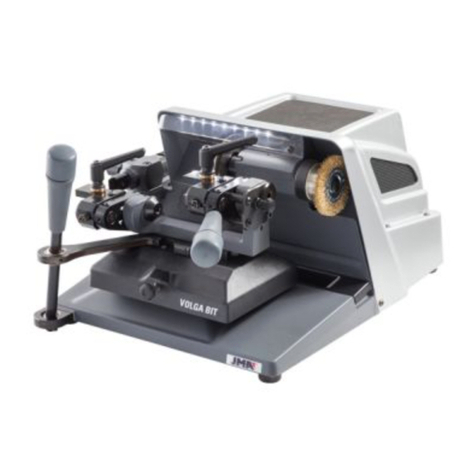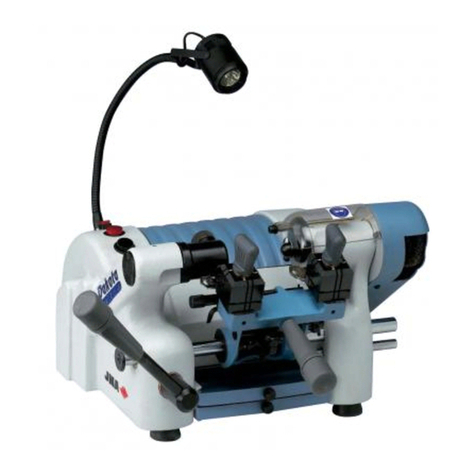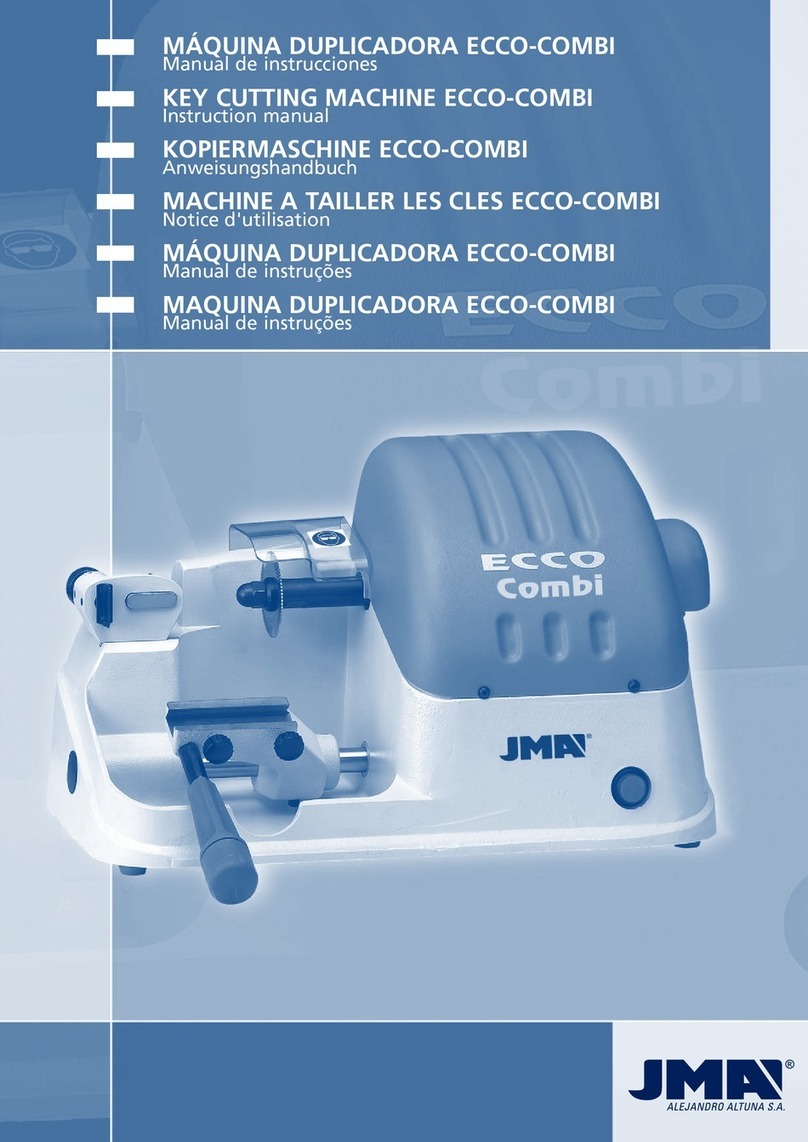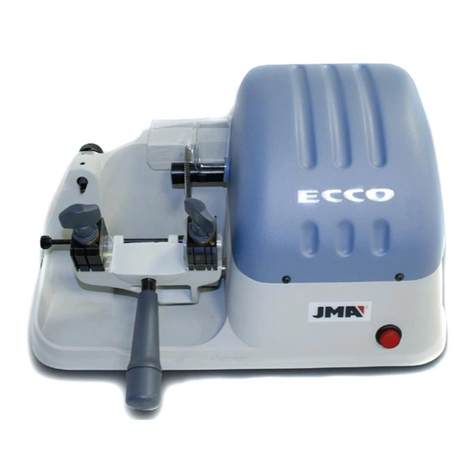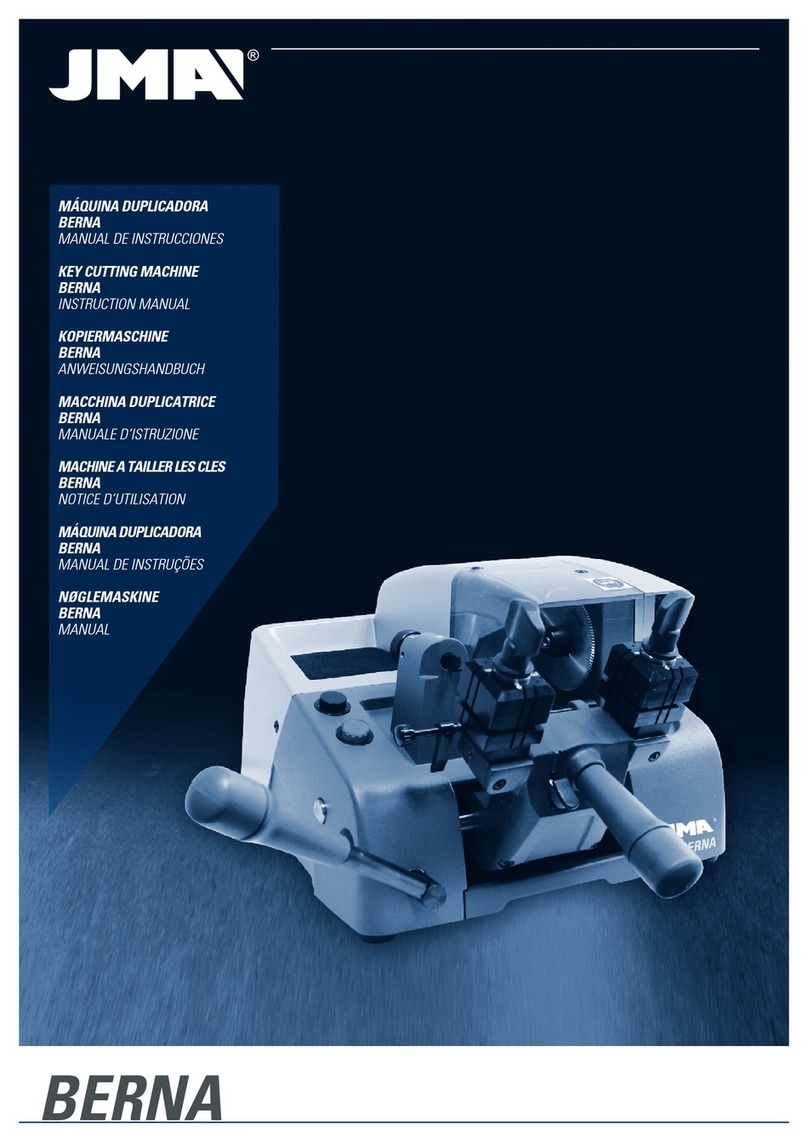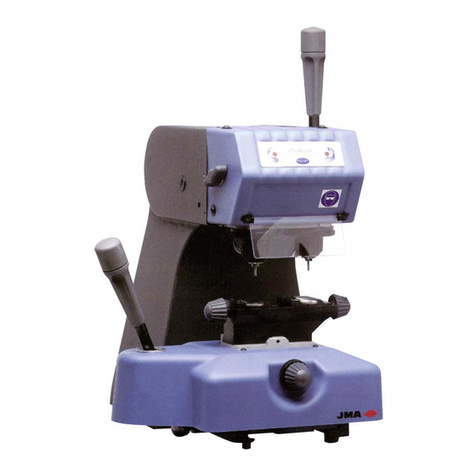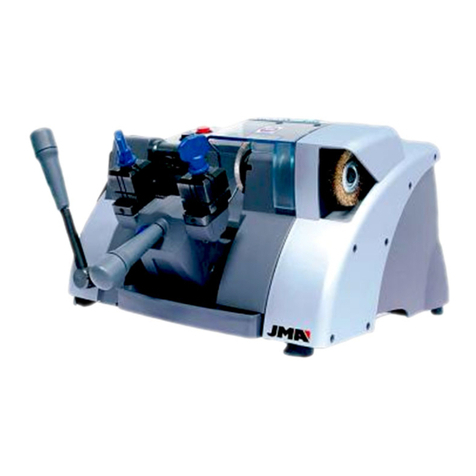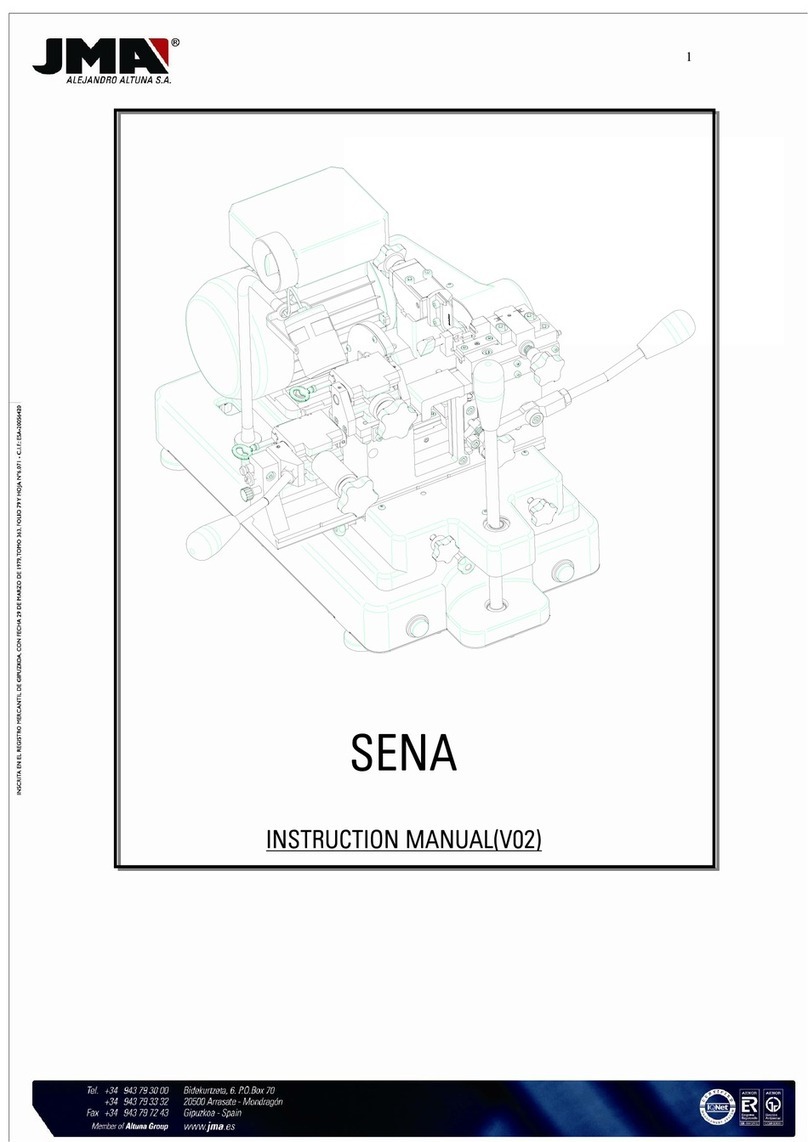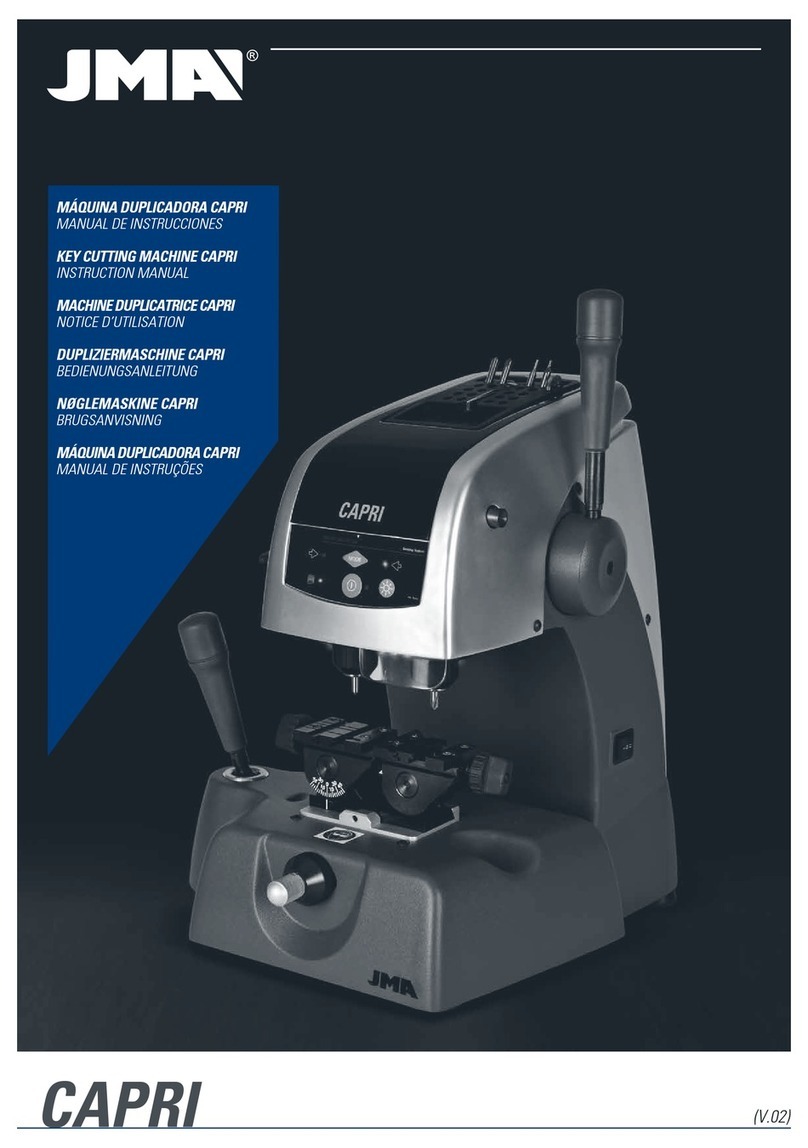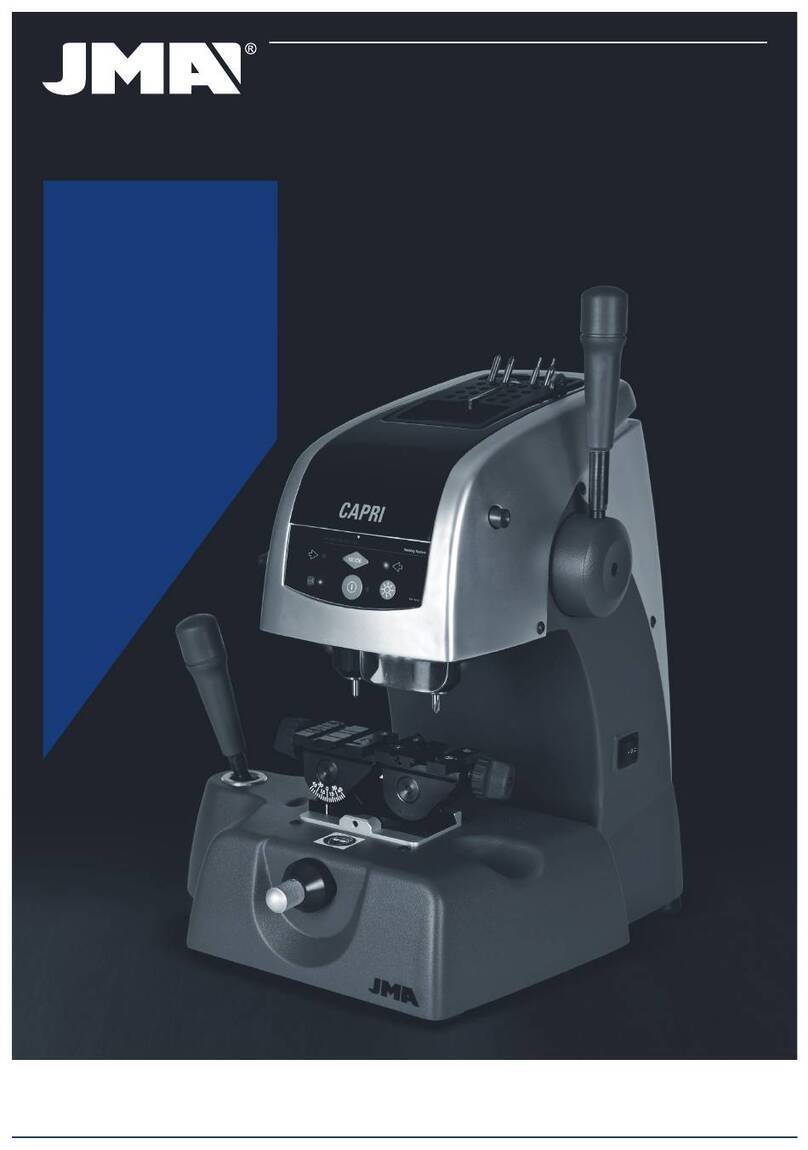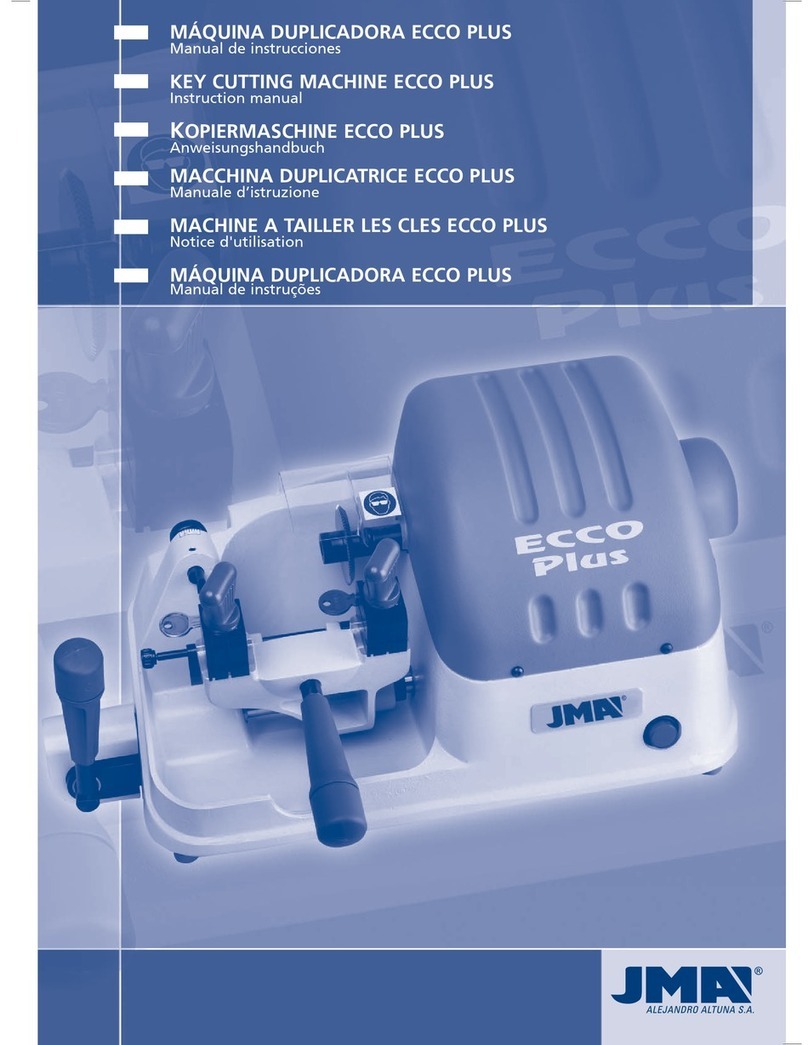
español
4.14 SUSTITUCIÓN DE LOS MICROINTERRUPTORES
Ver figura 26
Esta operación se realiza de la siguiente manera:
1) Apagar la máquina y desconectar el cable de alimentación.
2) Desenganchar el carro actuando sobre el Pulsador (M), y acercarlo hacia la Fresa-
Palpador, hasta que el propio carro haga su tope de avance.
3) Extraer la bandeja para viruta.
4) Girar la máquina, para poder acceder a la “Chapa de protección inferior”.
5) Desatornillar las 4 patas de la máquina, y extraerlas.
6) Desatornillar los 5 tornillos (10) que amarran la “Chapa de protección inferior”, y
retirarla.
7) Desenroscar las dos tuercas (19) y extraer los dos microinterruptores.
8) Desconectar los cables del viejo microinterruptor, anotando previamente la posición
de cada uno de ellos.
9) Conectar los cables al nuevo microinterruptor.
10) Montar de nuevo los dos microinterruptores, amarrándolos por medio de las dos
tuercas (19).
11) Colocar la “Chapa de protección inferior”, fijándola con los 5 tornillos (10).
12) Atornillar las 4 patas de la máquina.
13) Girar la máquina de manera que quede en posición de utilización.
14) Levantando y bajando el carro, verificar que los microinterruptores funcionen co-
rrectamente.
15) Montar en la máquina la bandeja para viruta.
4.15 SUSTITUCIÓN DEL DISPLAY
Ver figura 27
Esta operación se realiza de la siguiente manera:
1) Apagar la máquina y desconectar el cable de alimentación.
2) Introducir la varilla de bloqueo en el agujero del árbol de la fresa.
3) Desatornillar el tornillo que amarra el cepillo, y extraer el cepillo.
4) Desatornillar los 6 tornillos (6) que amarran el “Guarda lateral derecho”, y extraerlo.
5) Desatornillar los 6 tornillos (4) que amarran el “Guarda lateral izquierdo”, y despla-
zarlo ligeramente hacia la izquierda para poder tener acceso a dos de los siete tornillos
que amarran el “Guarda motor”.
6) Desatornillar los 7 tornillos (9) que amarran el “Guarda motor”, y extraerlo.
7) Desatornillar los 2 tornillos (20) que amarran el “Guarda electrónica”, y girarlo hacia
atrás para poder tener acceso a su parte inferior.
8) Extraer el conector del viejo display, anotando previamente la posición del conector.
9) Despegar el viejo display del “Guarda electrónica”, y extraerlo.
10) Pegar el nuevo display en el “Guarda electrónica”, de manera que quede centrado
en su cajera.
11) Enchufar el conector del display en la Tarjeta electrónica. Verificar que se ha conec-
tado en la posición correcta.
12) Colocar el “Guarda electrónica”, fijándolo con los 2 tornillos (20).
13) Colocar el “Guarda motor”, fijándolo con los 7 tornillos (9).
14) Colocar el “Guarda lateral izquierdo”, fijándolo con los 6 tornillos (4).
15) Colocar el “Guarda lateral derecho”, fijándolo con los 6 tornillos (6).
16) Colocar el cepillo, y amarrarlo por medio de su tornillo.
17) Retirar la varilla de bloqueo del árbol de la fresa.
4.16 SUSTITUCIÓN DE LA TARJETA ELECTRÓNICA
Ver figura 28
Esta operación se realiza de la siguiente manera:
1) Apagar la máquina y desconectar el cable de alimentación.
2) Introducir la varilla de bloqueo en el agujero del árbol de la fresa.
3) Desatornillar el tornillo que amarra el cepillo, y extraer el cepillo.
4) Desatornillar los 6 tornillos (6) que amarran el “Guarda lateral derecho”, y extraerlo.
5) Desatornillar los 6 tornillos (4) que amarran el “Guarda lateral izquierdo”, y despla-
zarlo ligeramente hacia la izquierda para poder tener acceso a dos de los siete tornillos
que amarran el “Guarda motor”.
6) Desatornillar los 7 tornillos (9) que amarran el “Guarda motor”, y extraerlo.
7) Desatornillar los 2 tornillos (20) que amarran el “Guarda electrónica”, y girarlo hacia
atrás para poder tener acceso a su parte inferior.
8) Extraer el conector del display, anotando previamente la posición del conector.
9) Desatornillar los 2 tornillos (21) que amarran la “Tarjeta electrónica” al “Guarda
electrónica”, y extraerla.
10) Desconectar los cables de la vieja “Tarjeta electrónica”, anotando previamente la
posición de cada uno de ellos.
11) Conectar los cables a la nueva “Tarjeta electrónica”. Verificar que se han conectado
en la posición correcta.
12) Colocar la “Tarjeta electrónica”, fijándola con los 2 tornillos (21).
13) Enchufar el conector del display en la Tarjeta electrónica. Verificar que se ha conec-
tado en la posición correcta.
14) Colocar el “Guarda electrónica”, fijándolo con los 2 tornillos (20).
15) Colocar el “Guarda motor”, fijándolo con los 7 tornillos (9).
16) Colocar el “Guarda lateral izquierdo”, fijándolo con los 6 tornillos (4).
17) Colocar el “Guarda lateral derecho”, fijándolo con los 6 tornillos (6).
Esta operación se realiza de la siguiente manera:
1) Apagar la máquina y desconectar el cable de alimentación.
2) Introducir la varilla de bloqueo en el agujero del árbol de la fresa.
3) Desatornillar el tornillo que amarra el cepillo, y extraer el cepillo.
4) Desatornillar los 6 tornillos (6) que amarran el “Guarda lateral derecho”, y extraerlo.
5) Desatornillar los 6 tornillos (4) que amarran el “Guarda lateral izquierdo”, y despla-
zarlo ligeramente hacia la izquierda para poder tener acceso a dos de los siete tornillos
que amarran el “Guarda motor”.
6) Desatornillar los 7 tornillos (9) que amarran el “Guarda motor”, y extraerlo.
7) Desatornillar los 4 tornillos (14) que amarran la tapa de la “caja de bornas”, y ex-
traerla.
8) Desconectar los dos cables del viejo condensador ( C ) y extraerlo.
9) Montar el nuevo condensador ( C ) y conectar sus dos cables.
10) Colocar la tapa de la “caja de bornas”, fijándola con los 4 tornillos (14).
11) Colocar el “Guarda motor”, fijándolo con los 7 tornillos (9).
12) Colocar el “Guarda lateral izquierdo”, fijándolo con los 6 tornillos (4).
13) Colocar el “Guarda lateral derecho”, fijándolo con los 6 tornillos (6).
14) Colocar el cepillo, y amarrarlo por medio de su tornillo.
15) Retirar la varilla de bloqueo del árbol de la fresa.
4.10 SUSTITUCIÓN DE LA LEVA DE ELEVACIÓN DE LA
MORDAZA
Ver figura 22
Si por un desgaste excesivo de la “Leva de elevación de la mordaza” fuese necesaria su
sustitución, actuar de la siguiente manera:
1) Apagar la máquina y desconectar el cable de alimentación.
2) Desenroscar la Maneta de la mordaza (B), y extraer la mordaza.
3) Con ayuda de un pequeño botador, golpear el pasador (16) hasta lograr expulsarlo
por la parte inferior del carro.
4) Extraer la maneta (G) junto a su eje, tirando de ella en la dirección axial.
5) Extraer la leva vieja. Para ello, nos podemos ayudar con una pequeña varilla que
empuje la leva vieja desde la parte inferior del carro, para hacer que salga por la parte
superior del carro.
6) Introducir la nueva leva en su hueco, a la vez que introducimos el eje de la maneta
(G) en su agujero.
7) Hacer coincidir el agujero del eje de la maneta (G), con el agujero de la nueva leva.
En esta posición, introducir el pasador (16).
8) Volver a montar la mordaza y su correspondiente maneta (B).
4.11 ACCESO AL INTERIOR DEL CARRO
Ver figura 23
Para cualquier operación de mantenimiento que requiera acceder al interior del carro,
actuar de la siguiente manera:
1) Apagar la máquina y desconectar el cable de alimentación.
2) Extraer la bandeja para viruta.
3) Girar 90º las dos manetas (G), para más adelante poder retirar sin obstáculos la
“Tapa carro”.
4) Desenganchar el carro actuando sobre el Pulsador (M), y acercarlo hacia la Fresa-
Palpador, hasta que el propio carro haga su tope de avance.
5) Desenroscar la “Palanca de mando del carro”, y extraerla.
6) Desatornillar los 4 tornillos (15) que amarran la “Tapa carro”, y extraerla.
4.12 TENSADO DEL MUELLE DEL CARRO
Ver figura 24
Esta operación se realiza de la siguiente manera:
1) Apagar la máquina y desconectar el cable de alimentación.
2) Acceder al interior del carro, tal y como se explica en el apartado anterior.
3) Con ayuda de dos llaves allen del nº4, aflojar los dos prisioneros (17) del Tensor (18):
Aflojar uno de los dos prisioneros. Después, con una de las llaves allen aflojar el segun-
do prisionero, mientras que la segunda llave allen nos sirve para sujetar el Tensor (18)
evitando que gire de manera inesperada al aflojar el segundo prisionero.
4) Con la llave allen introducida en el prisionero (17), girar el Tensor (18) hasta alcan-
zar la fuerza deseada. En esta posición, bloquear el Tensor (18) por medio de los dos
prisioneros (17).
4.13 ACCESO AL VANO INFERIOR
Ver figura 25
Para cualquier operación de mantenimiento que requiera acceder al vano inferior de la
máquina, actuar de la siguiente manera:
1) Apagar la máquina y desconectar el cable de alimentación.
2) Extraer la bandeja para viruta.
3) Girar la máquina, para poder acceder a la “Chapa de protección inferior”.
4) Desatornillar las 4 patas de la máquina, y extraerlas.
5) Desatornillar los 5 tornillos (10) que amarran la “Chapa de protección inferior”, y
retirarla.






